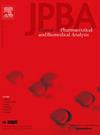基于非靶向平台的雷帕霉素对非酒精性脂肪肝大鼠肝脏代谢组学的影响
IF 3.1
3区 医学
Q2 CHEMISTRY, ANALYTICAL
Journal of pharmaceutical and biomedical analysis
Pub Date : 2024-10-22
DOI:10.1016/j.jpba.2024.116541
引用次数: 0
摘要
雷帕霉素(Rapamycin,Rapa)是一种mTOR复合物抑制剂,本文研究了它对非酒精性脂肪肝(NAFLD)大鼠肝功能的治疗效果。并基于非靶向代谢组学分析初步阐明了Rapa在非酒精性脂肪肝中的可能作用机制。成年雄性SD大鼠以高脂肪、高胆固醇饮食(HFD)建立非酒精性脂肪肝模型。在拉帕组中,HFD大鼠摄入0.8 mg/(kg.d)拉帕。采用超高效液相色谱法和Q-TOF/MS质谱法鉴定大鼠血清中的代谢物,并利用京都基因组百科全书(KEGG)进行注释。非酒精性脂肪肝大鼠的肝功能、脂质代谢和氧化应激均出现紊乱,但拉帕对这些紊乱有缓解作用。代谢物图谱数据确定了 579 种代谢物,这些代谢物在 Rapa 组和 HFD 组之间存在显著差异,主要类别包括氨基酸和肽、苯、脂类和脂肪酸。差异代谢物主要涉及辅助因子的生物合成、胆汁分泌和甘油磷脂代谢。总之,Rapa 对 HFD 引起的非酒精性脂肪肝具有潜在的保护作用,其保肝作用可能是通过介导胆汁分泌和甘油磷脂代谢实现的。本文章由计算机程序翻译,如有差异,请以英文原文为准。
Effect of rapamycin on hepatic metabolomics of non-alcoholic fatty liver rats based on non-targeted platform
Rapamycin (Rapa) is an inhibitor of mTOR complex, and its therapeutic effect on liver function was examined in non-alcoholic fatty liver disease (NAFLD) rats here. And the possible mechanism of Rapa in NAFLD was preliminarily elucidated based on the non-targeted metabolomics analysis. Adult male SD rats were fed with a high-fat and high-cholesterol diet (HFD) to establish NAFLD model. For Rapa group, 0.8 mg/(kg.d) Rapa was given to the HFD rats. Ultra-performance liquid chromatography and Q-Tof-mass spectrometry (UPLC and Q-TOF/MS) analysis were applied for the identification of metabolites in the serum of rats, which were annotated using Kyoto Encyclopedia of Genes and Genomes (KEGG). NAFLD rats presented with disturbed liver function, lipid metabolism and oxidative stress, but Rapa exerted a mitigating influence on the disorders. The metabolite profile data identified 579 metabolites that varied remarkably between the Rapa and HFD groups, with the main classes of amino acids and peptides, benzene, lipids and fatty acids. The differential metabolites were mainly involved in biosynthesis of cofactors, bile secretion, and glycerophospholipid metabolism were mainly enriched. In conclusion, Rapa has a potential protective effect against HFD-induced NAFLD, its hepatoprotective effect may achieved through mediating bile secretion and glycerophospholipid metabolism.
求助全文
通过发布文献求助,成功后即可免费获取论文全文。
去求助
来源期刊
CiteScore
6.70
自引率
5.90%
发文量
588
审稿时长
37 days
期刊介绍:
This journal is an international medium directed towards the needs of academic, clinical, government and industrial analysis by publishing original research reports and critical reviews on pharmaceutical and biomedical analysis. It covers the interdisciplinary aspects of analysis in the pharmaceutical, biomedical and clinical sciences, including developments in analytical methodology, instrumentation, computation and interpretation. Submissions on novel applications focusing on drug purity and stability studies, pharmacokinetics, therapeutic monitoring, metabolic profiling; drug-related aspects of analytical biochemistry and forensic toxicology; quality assurance in the pharmaceutical industry are also welcome.
Studies from areas of well established and poorly selective methods, such as UV-VIS spectrophotometry (including derivative and multi-wavelength measurements), basic electroanalytical (potentiometric, polarographic and voltammetric) methods, fluorimetry, flow-injection analysis, etc. are accepted for publication in exceptional cases only, if a unique and substantial advantage over presently known systems is demonstrated. The same applies to the assay of simple drug formulations by any kind of methods and the determination of drugs in biological samples based merely on spiked samples. Drug purity/stability studies should contain information on the structure elucidation of the impurities/degradants.

 求助内容:
求助内容: 应助结果提醒方式:
应助结果提醒方式:


